Reviewer's Note: This is a review of a custom modified light – in this case, from the well-known CPF modder Vinh Nguyen (V54). For more information on Vinh's lights, please check out the vinhnguyen54 subforum of the CPF Custom Flashlight Builders and Modders forum. There is a specific thread for information on the K40Lvn.
Also, due to a large backlog of lights that I have to test, I will limit some of the descriptive text in my reviews for the time being. Full commentaries are still provided under the Potential Issues and the Preliminary Discussion sections, but I will let the pictures and graphs speak more themselves in the body of the review.
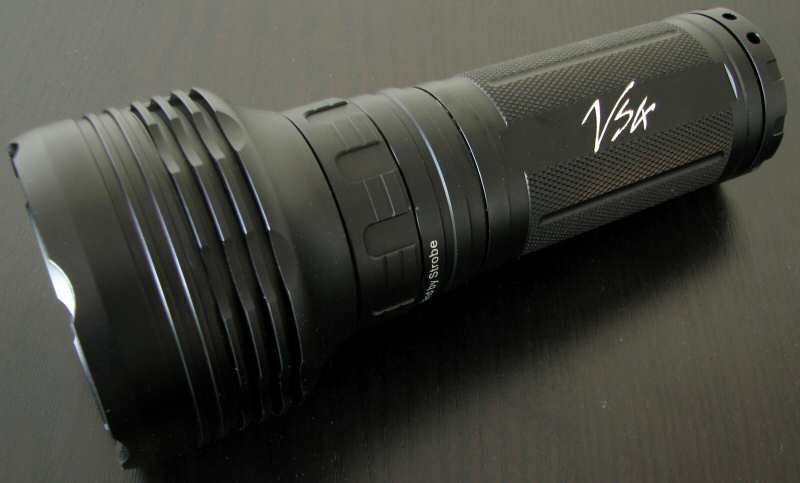
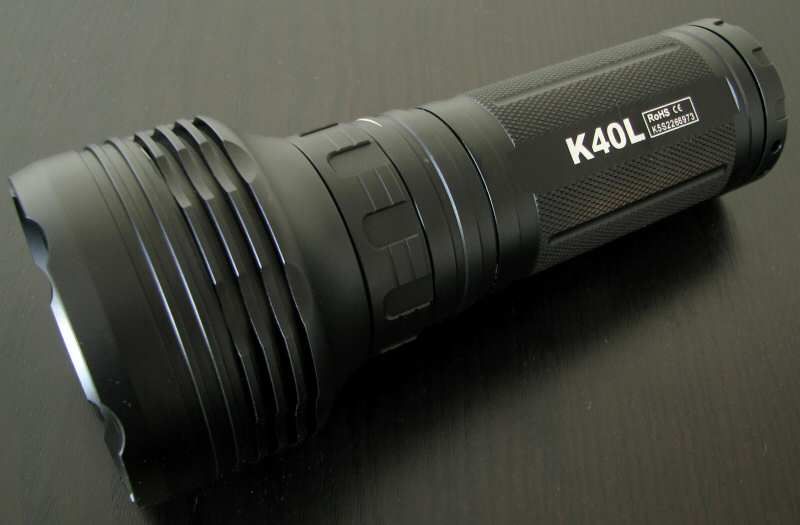
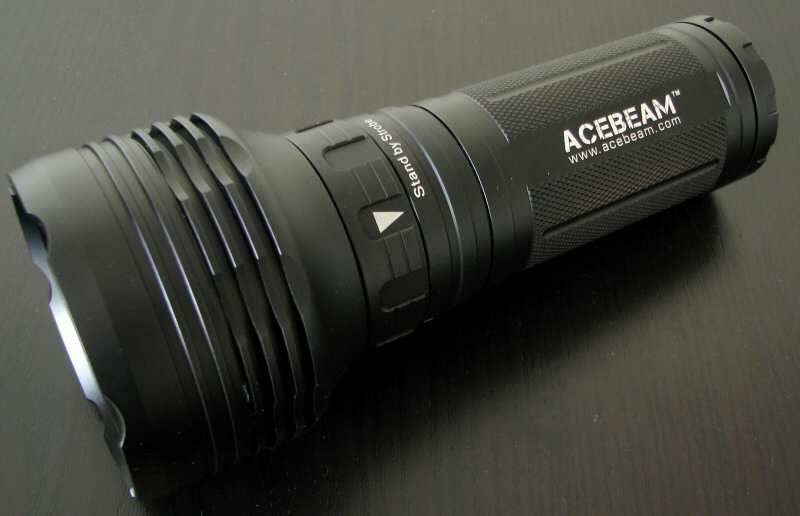
The stock K40L is a slightly smaller version of the K50 that I reviewed previously (under the SupBeam name). It lacks the in-light charging of the larger K50, and will of course have less throw (but still a lot). It also has an identical build to the K40M (except for the larger MT-G2 emitter in that case).
I have two versions of Vinh's modification on hand for testing – a dedomed stock XP-L, and a dedomed XP-G2 (with Vinh's PDTc - "premium dedome tint – cool white"). Let's see how they perform.
Stock Acebeam K40L Reported Specifications:
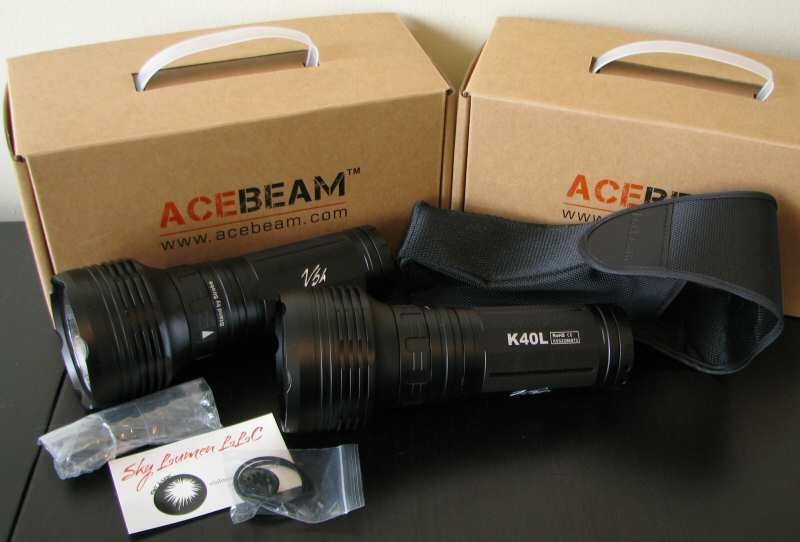
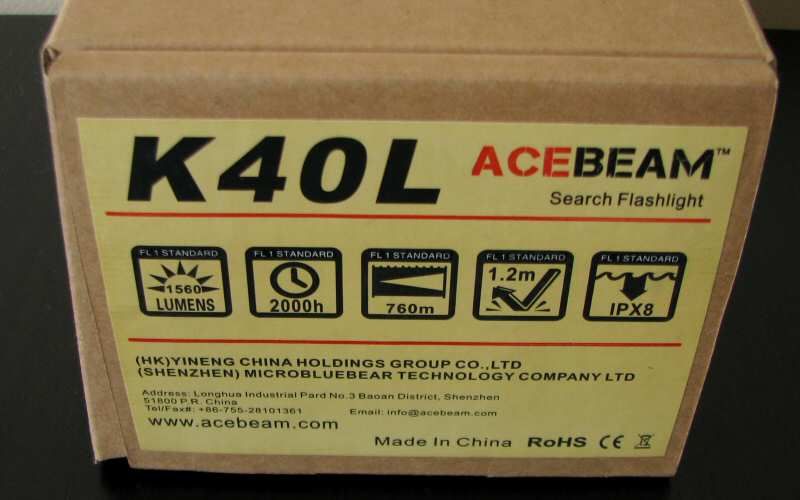
As per usual for a V54-modded light, packaging of the K40Lvn is the standard stock packaging of the K40L. The K40L comes in a plain cardboard box with packing foam. Along with the light is a holster, extra o-rings, spare boot switch cover, decent quality wrist strap, warranty card, manual, and Vinh's business card.
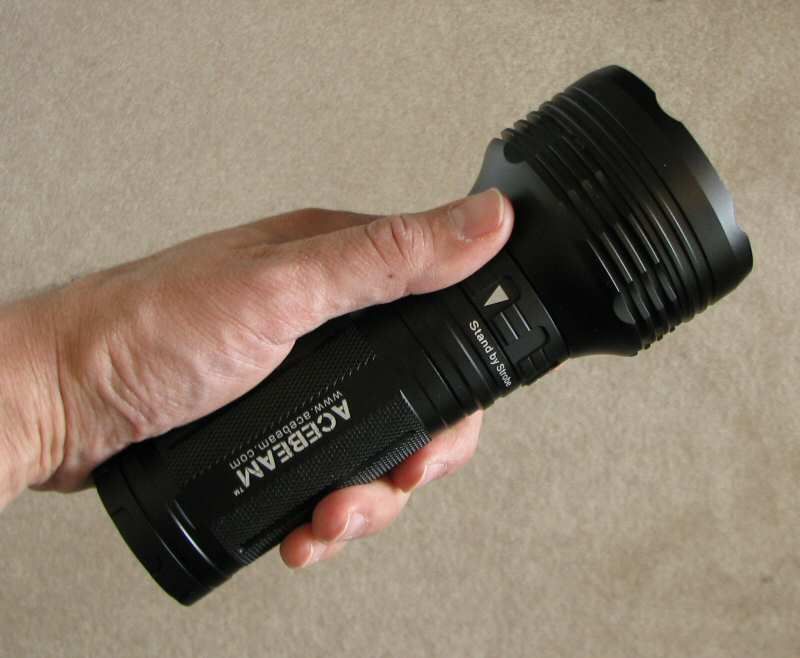
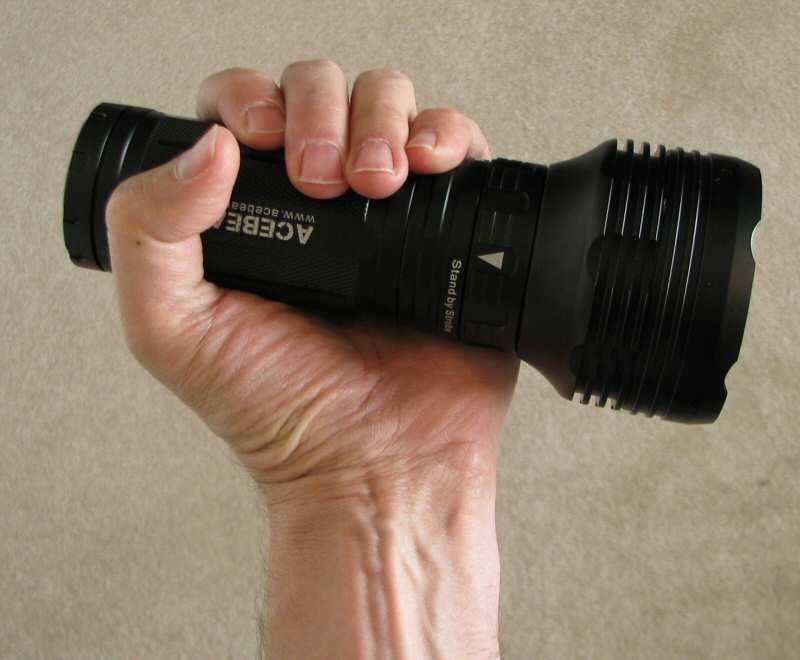
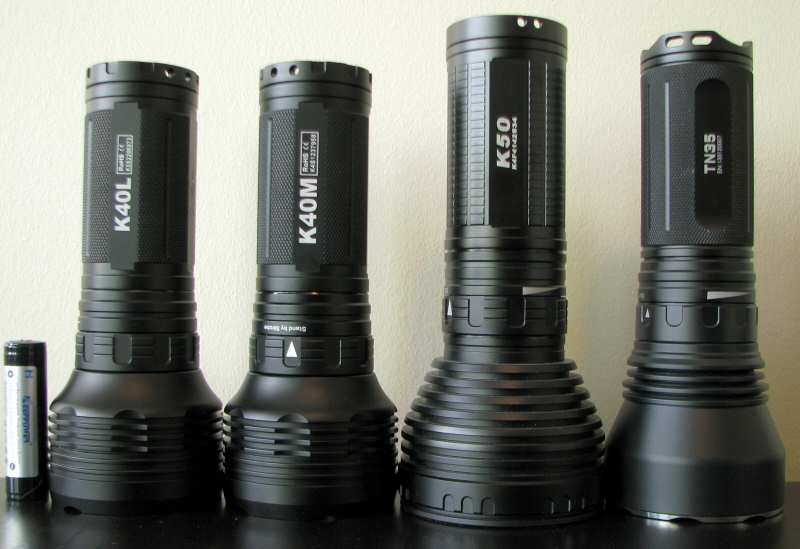
From left to right: Keeppower protected 18650 3100mAh; Acebeam K40Lvn, K40M; SupBeam K50; Thrunite TN35.
All dimensions are directly measured, and given with no batteries installed:
AceBeam K40Lvn XP-L: Weight: 533.8g, Length: 188mm, Width (bezel): 76.2mm
AceBeam K40Lvn XP-G2: Weight: 539.1g, Length: 188mm, Width (bezel): 76.2mm
AceBeam K40M: Weight: 498.4g, Length: 188mm, Width (bezel): 76.2mm
SupBeam K50vn: Weight: 645.9g, Length: 230mm, Width (bezel): 90.1mm
SupBeam K50: Weight: 645.0g, Length: 230mm, Width (bezel): 90.1mm
Eagletac MX25L3C 3x18650: Weight: 345.9g, 352.0g with kit tailcap (485-491g with 4x18650), Length: 141.9mm, 143.6mm with kit tailcap, Width (bezel): 61.9mm
Fenix TK61: Weight: 605.7g (790g with 4x18650), Length: 218mm, Width (bezel): 96.0mm
Fenix TK61vn: Weight: 608.0g (792g with 4x18650), Length: 218mm, Width (bezel): 96.0mm
Fenix TK75: Weight: 516.0g (700g with 4x18650), Length: 184mm, Width (bezel): 87.5mm
Niwalker BK-FA01 (XM-L2): Weight: 682.3g (864g with 4x18650), Length: 209mm, Width (bezel): 80.0mm, Width (tailcap): 50.3mm
Olight SR52vn: Weight: 401.1g (501g with 6xCR123A), Length: 162mm, Width (bezel): 63.1mm
Olight SR52: Weight: 396.7g (497g with 6xCR123A), Length: 162mm, Width (bezel): 63.1mm
Thrunite TN32 (XM-L2): Weight: 655.9g (808g with 3x18650), Length: 201mm, Width (bezel): 79.0mm
It's interesting to note the higher weight of the K40Lvn mod compared to the K40M (which should be comparable to the stock K40L). That extra 1.2oz (34g) copper heatsink is clearly registering in the weights. :thumbsup:
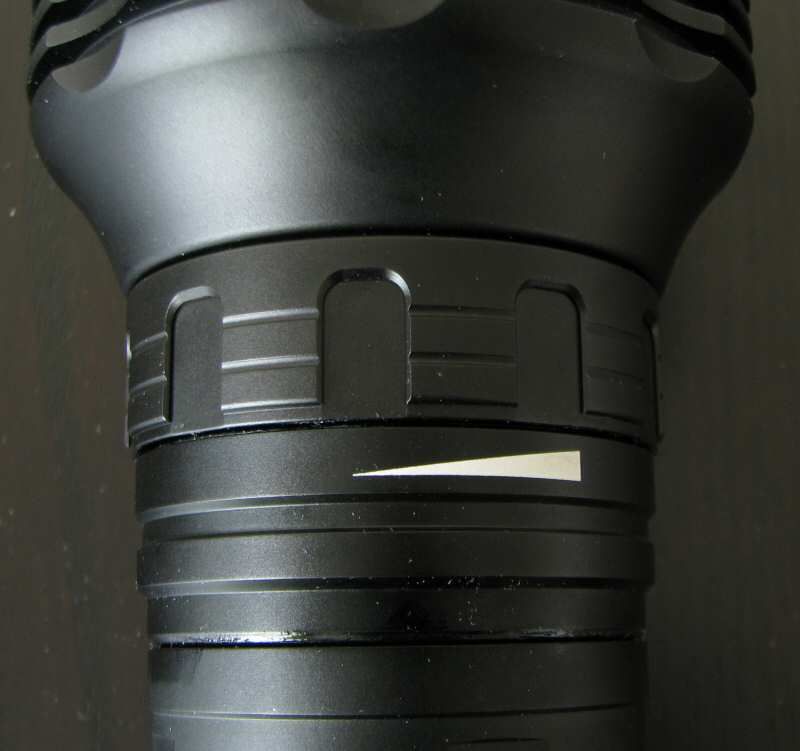
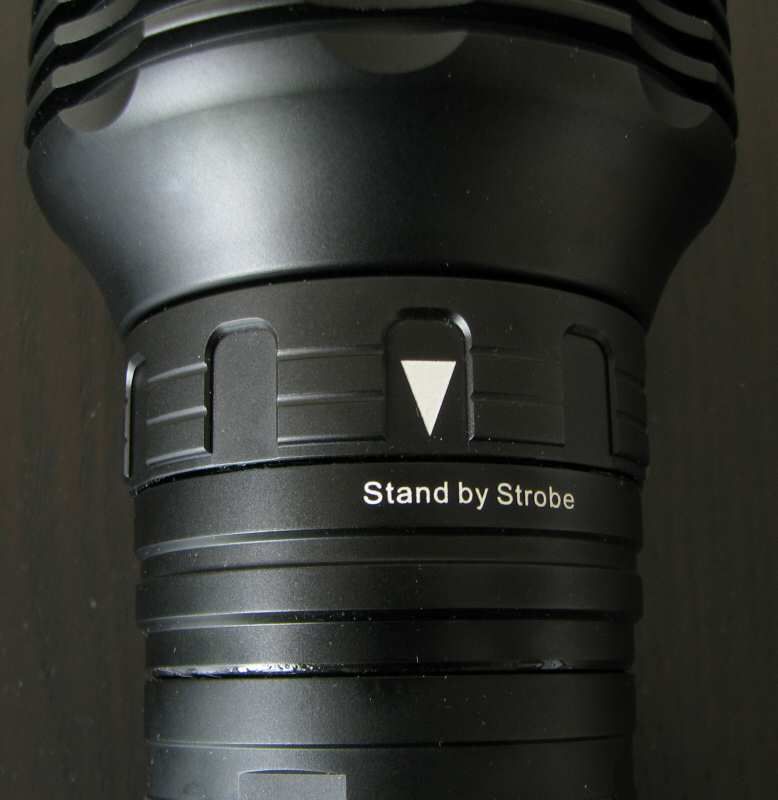
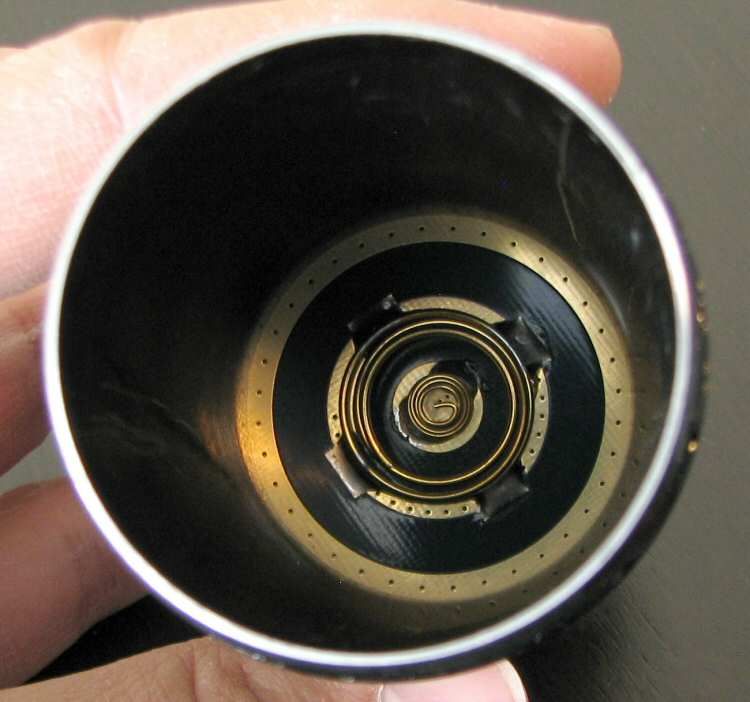
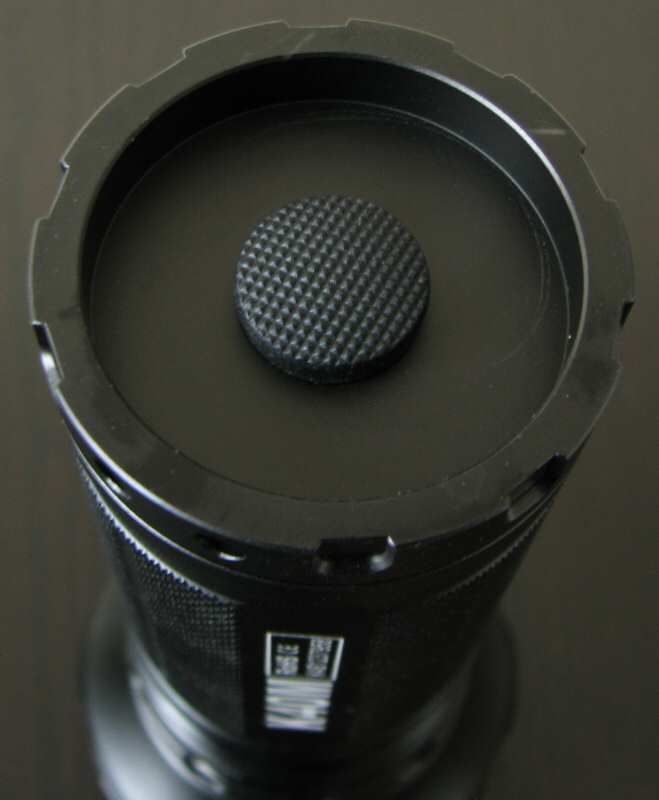
The only difference to the external styling of the lights is the custom "V54" engraving on the K40Lvn, should you request it.
The K40L build is similar to the K50 reviewed previously, minus the magnetic charging dock and in-light charger. As before, overall build is reminiscent of the Thrunite TN3x-series lights. Anodizing is a flat black, and seems to be in very good shape on my sample. Labels are sharp and clear, and include a serial number.
Rather than traditional knurling, the handle has a checkered pattern. Combined with the ridge detail on the control ring and head, overall grip is pretty good. The light can roll easily however.
The control ring feels and looks like K50. All black, there are slight indents (and raised checkered regions) on the control ring to help with feel. There is a label mark on the control ring that lines up with the labels on the head. The six constant output modes are not individually labeled, but there is a graded output bar pictogram over the first four levels (i.e., shows the direction to turn to raise or lower the output). There are firm detents at each level, with a slight click as you enter into each one.
Screw threads are traditional triangular cut, but seem of good quality. They are anodized, but it is the tension on the spring in the head than determines if you cam lock out the light by a twist. On my sample, a quick turn is enough to lock out the light.
The lights can tailstand. Tailcap has cut-outs to facilitate access to the switch. Switch is a forward clicky switch (i.e., press for momentary, click for locked-on).
Internally, the modded K40Lvn lights received a number of upgrades. Typically, Vinh shores up the internal heatsinking by adding a copper heatsink, and upgraded various components (wires, solder joints, etc.). You can certainly spot the extra weight, compared to the stock K40M in my testing (I don't have a stock K40L).
You can certainly spot the extra weight, compared to the stock K40M in my testing (I don't have a stock K40L).
Let's take a closer look at the battery carrier:
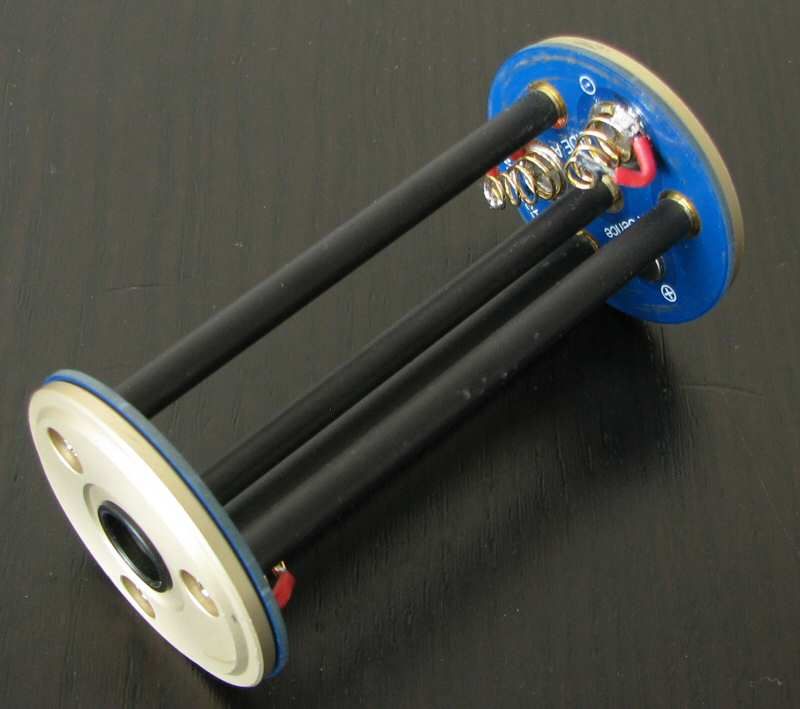
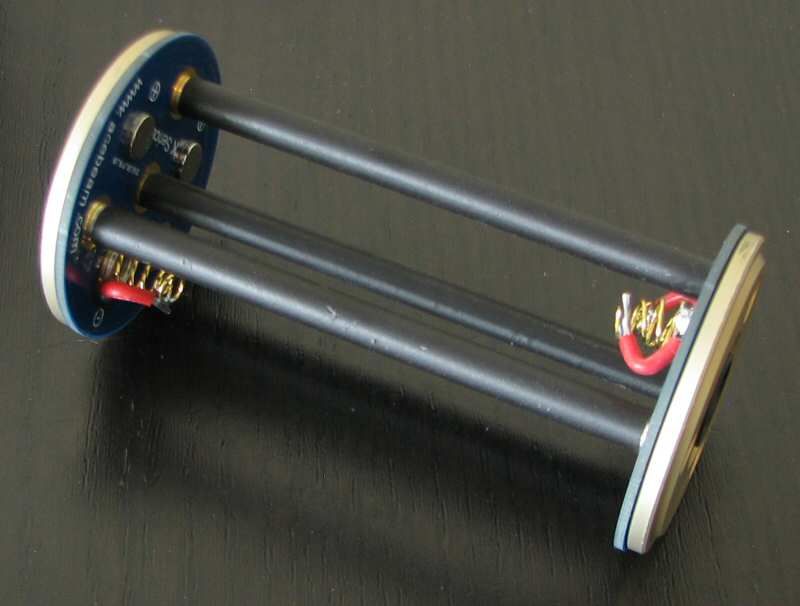
This is one of the few visible sources of Vinh's mod – you can see the additional wires soldered from the negative terminals to the springs in the carrier. This is to ensure good consistent current flow, through low-resistance wire.
The positive contact points inside the carrier are slightly raised, so all types of 18650 cells should work fine (i.e., true flat-tops, wide and small button-tops). There seems to be plenty of room in the carrier for length, so longer cells should fit fine. All the cells point the same way here (i.e., negative terminals at the base, positive terminals toward the head).
K40Lvn - XP-G2 dedome
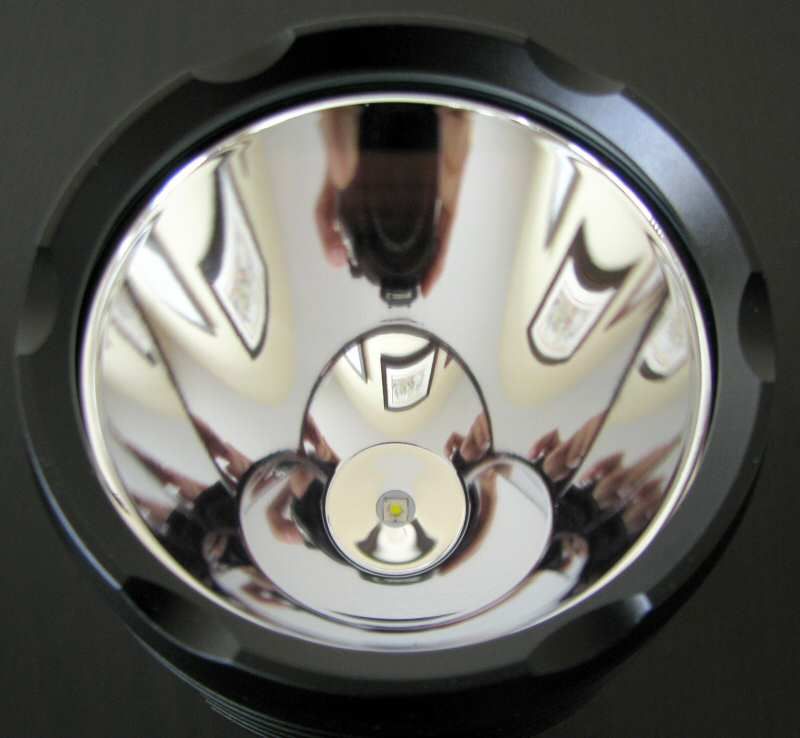
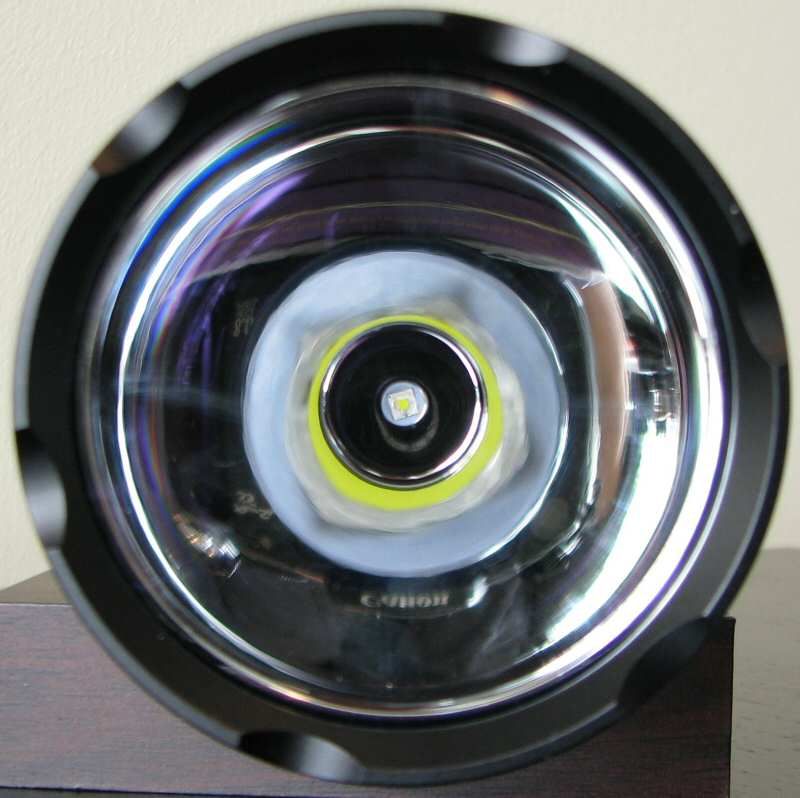
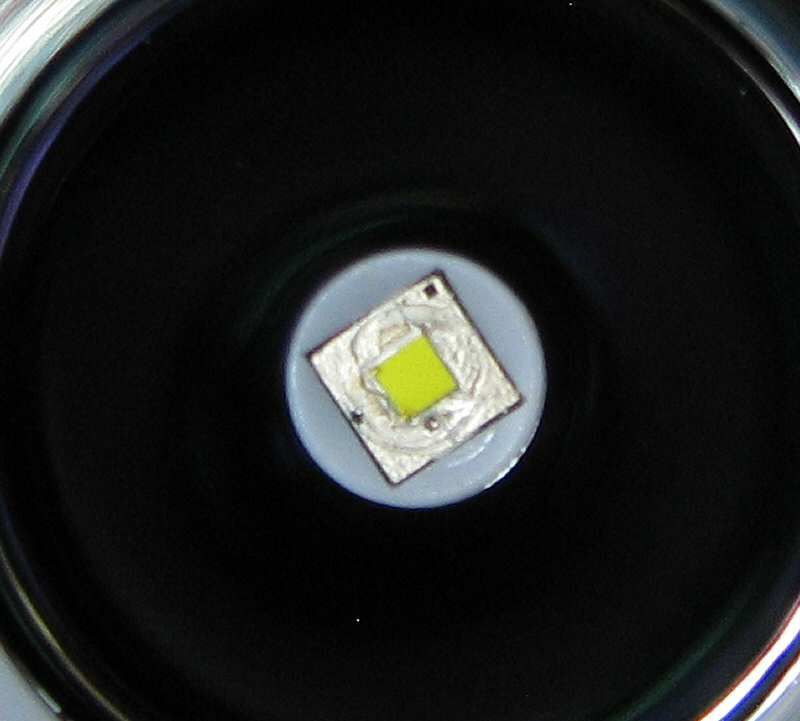
K40Lvn - XP-L dedome
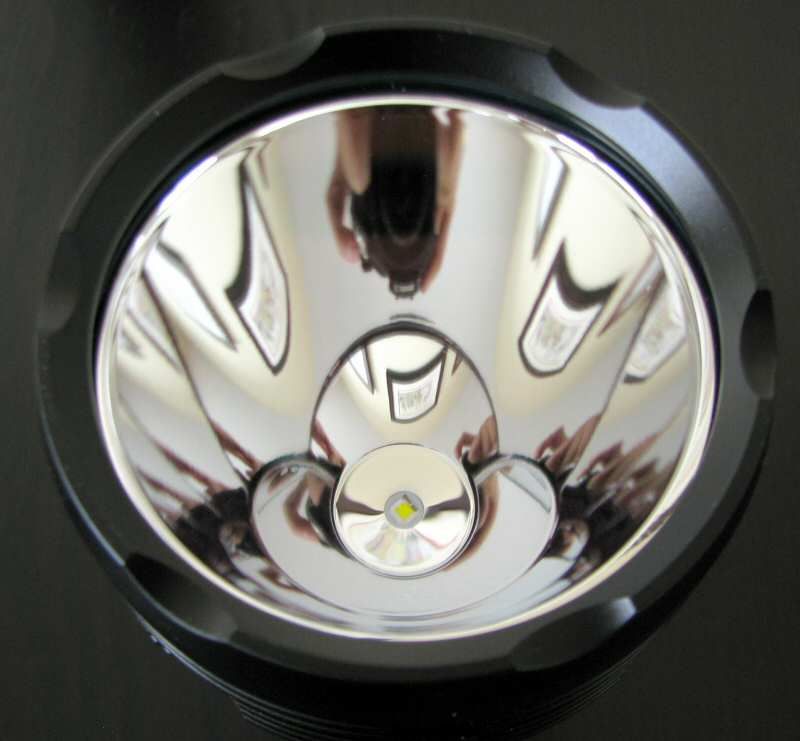
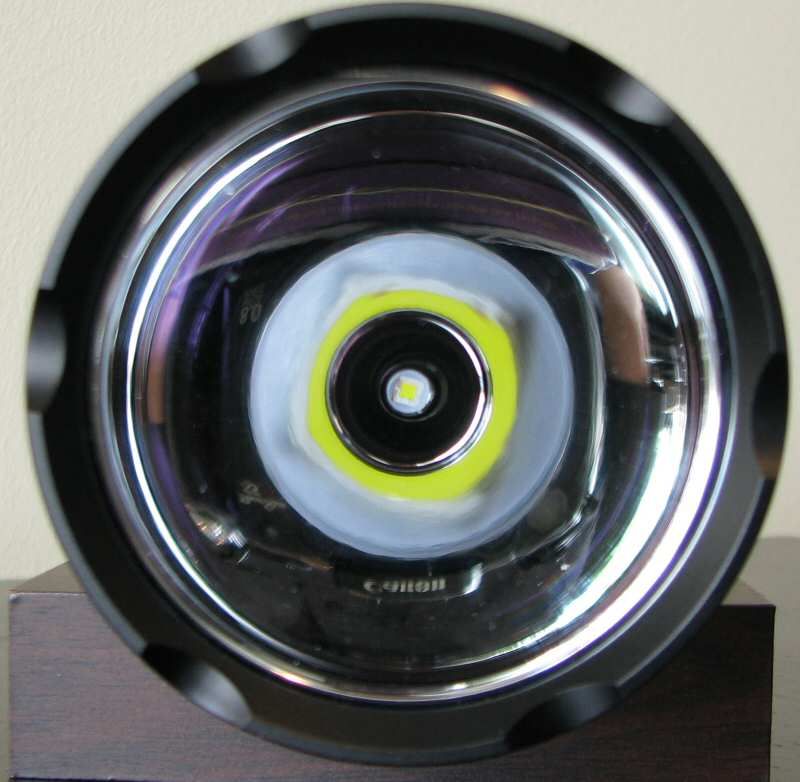
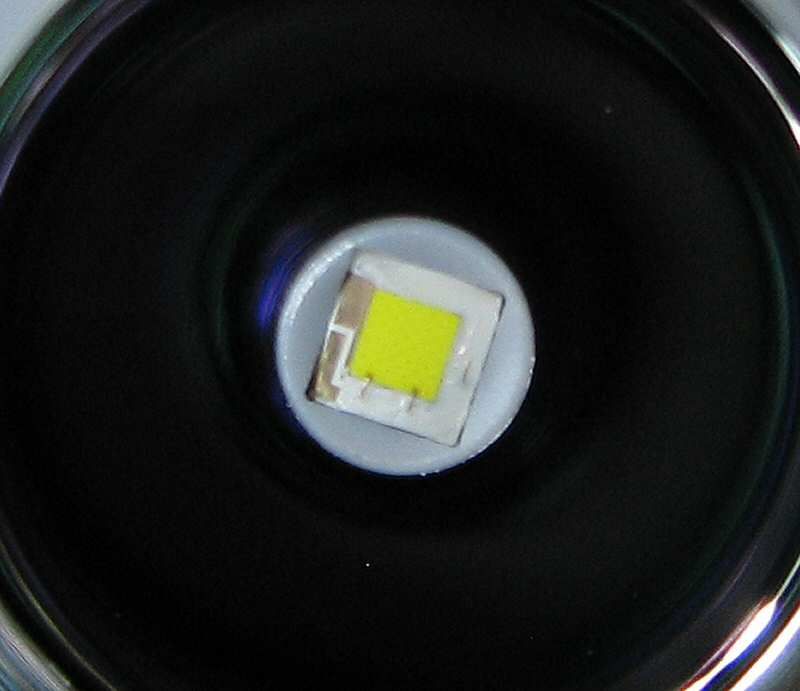
The stock K40L head is clearly designed for throw, being relatively smooth and deep (although not as large as 4x18650 K50).
The dedome XP-L and XP-G2 versions were both centered (and well dedomed). The dedoming process greatly improves the focusing of the light. Scroll down for beamshots and direct intensity measures. :wave:
User Interface
The UI is unaffected by the mod. Turn the light off/on by the tailcap clicky – press for momentary, press and release (i.e., click) for constant on.
Change output modes by turning the control ring in the head. Arranged from left-to-right (looking down at the light, held in traditional flashlight carry), the modes are level 1 > level 2 > level 3 > level 4 > level 5 > level 6 (max) > standby > tactical strobe.
No light is produced on standby, but a miniscule current will be drawn to allow the circuit to respond to a ring turn (see below). As always, I recommend you store the light clicked-off at the tailcap, or locked-out by a head twist.
Video:
For more information on the modded K40Lvn, please see my brief overview here:
As with all my videos, I recommend you have annotations turned on. I commonly update the commentary with additional information or clarifications before publicly releasing the video.
Strobe
There is no sign of PWM on any level – the lights are current-controlled. :thumbsup:
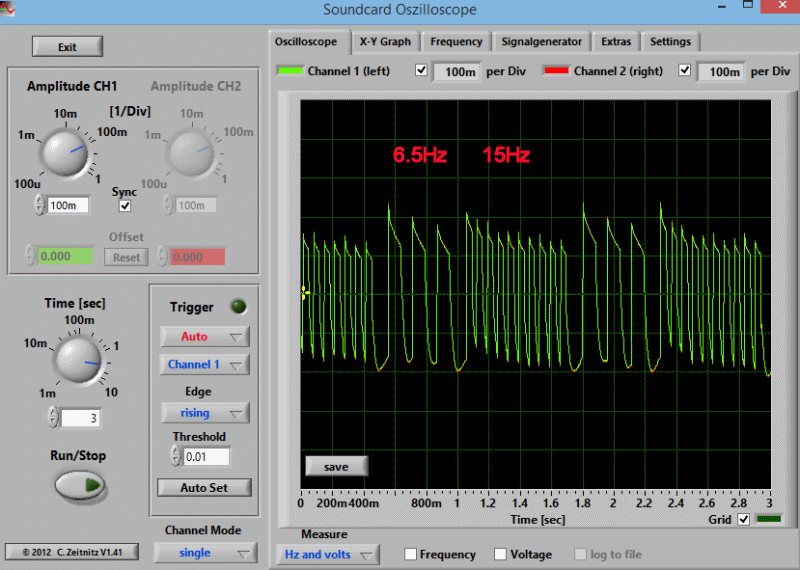
The K40L uses an oscillating strobe design, switching between two frequencies every ~0.6secs or so. Here is a blow up of the two frequencies:
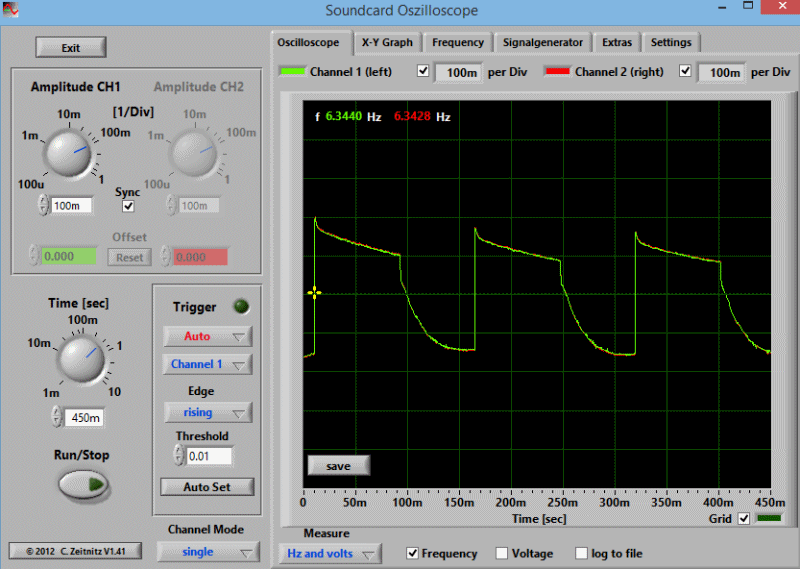
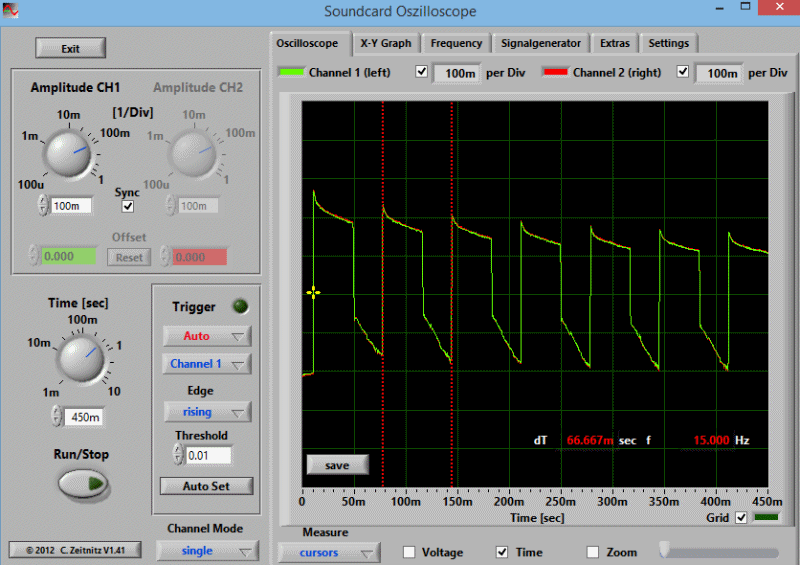
As you can see, it rapidly switches between 15.0Hz and 6.4Hz. This is exactly the same as the K50, K50vn and K40M that I previously tested.
Standby Drain
There must be a standby drain when the clicky switch is turned on and the light is in standby position of the control ring. I measured this traditional standby current as 60uA on 3x18650. This is similar to my K50, and not a major concern. Given the in-series arrangement, that would take almost 6 years to fully drain 3100mAh cells.
Note that on other lights that use a similar design (e.g., Thrunite TN3x series), I know there is an additional circuit to assist the switch when high current draw is required. This necessitates a secondary circuit in the tailcap that has its own standby drain when connected to the carrier. Typically, these are in the uA range and not a concern in practice (although it would be additive to the carrier drain below when fully connected).
Beamshots:
And now, what you have all been waiting for. All lights are on their respective 18650 battery sources, about ~0.75 meter from a white wall (with the camera ~1.25 meters back from the wall). Daylight white balance used on the V54 modded lights.
All lights are on their respective 18650 battery sources, about ~0.75 meter from a white wall (with the camera ~1.25 meters back from the wall). Daylight white balance used on the V54 modded lights.
And sorry in advance – all beamshots should say "XP-L dedome" for the second K40Lvn, not XM-L2.
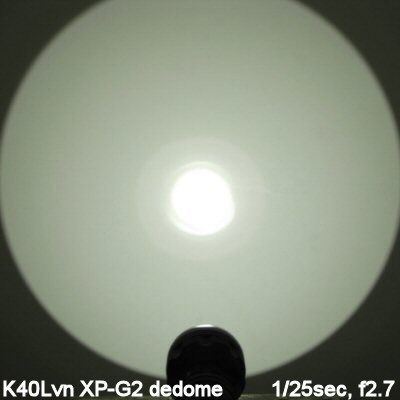
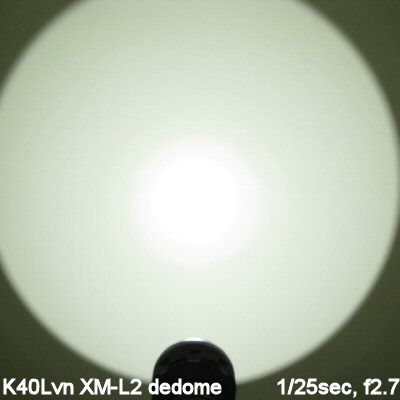
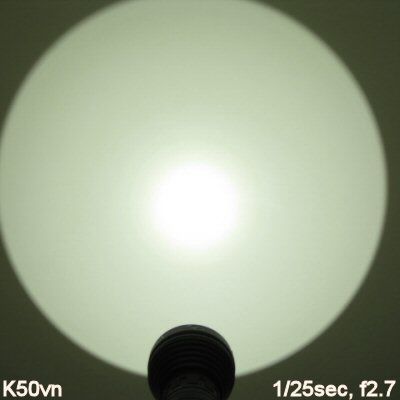
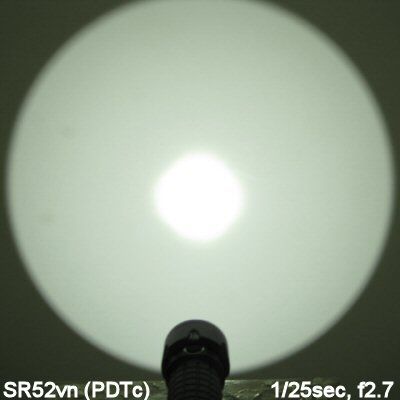
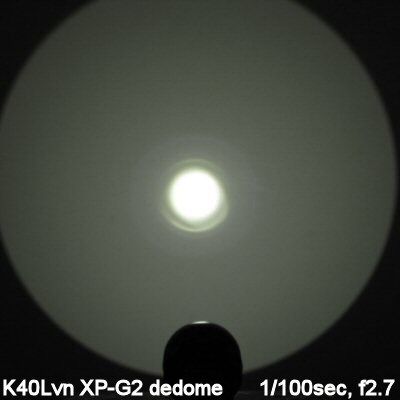
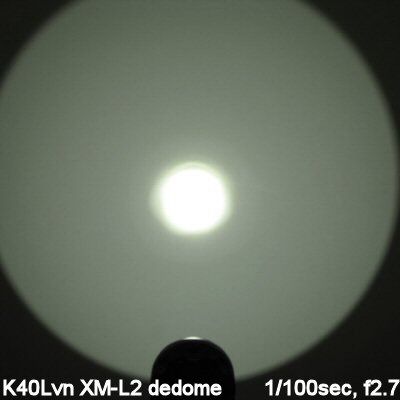
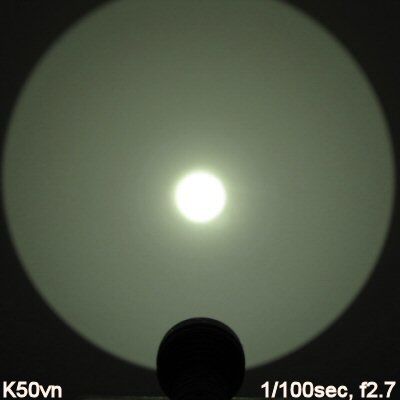
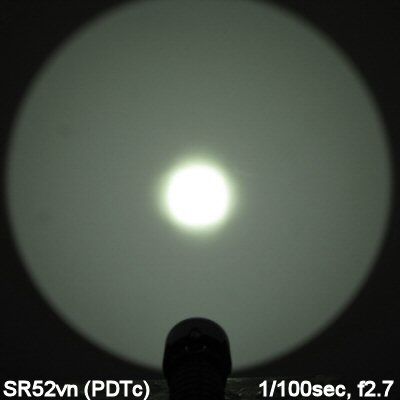
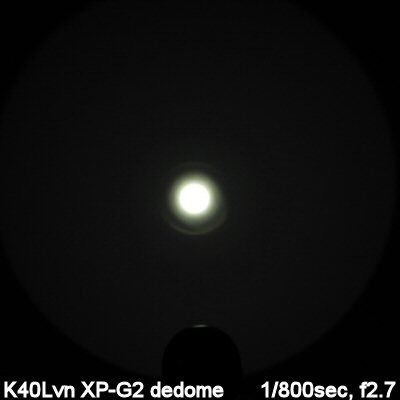
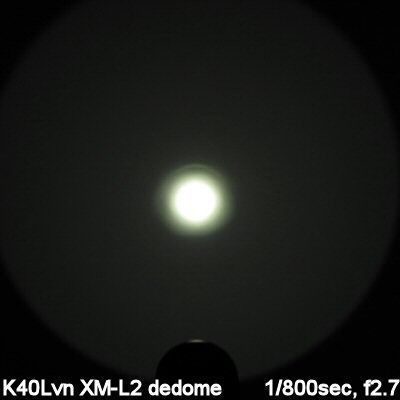
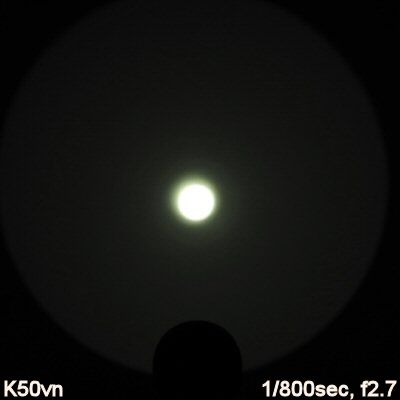
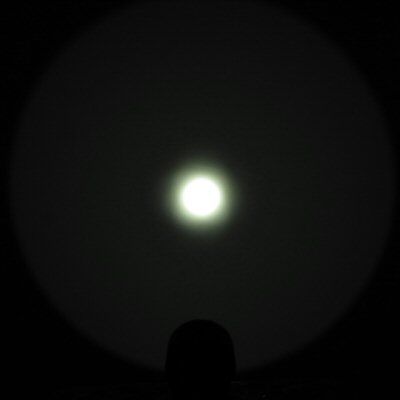
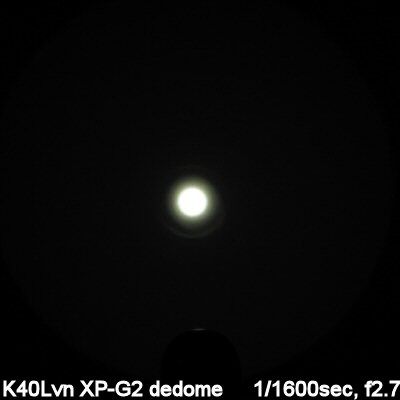
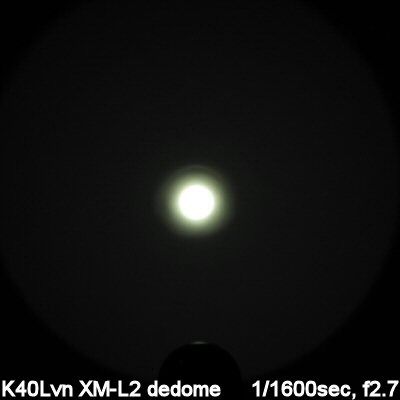
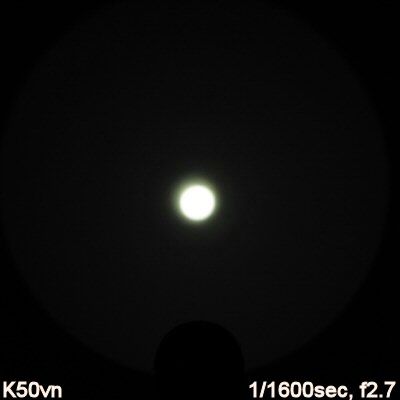
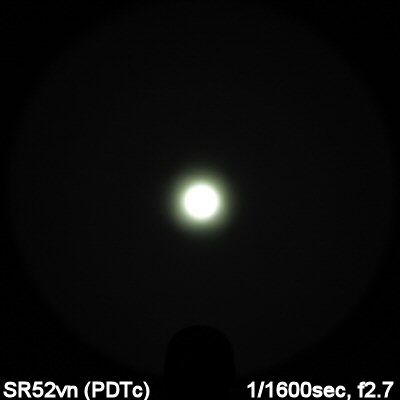
It is always, it's hard to tell much about peak intensity throw at such ridiculously close distances. The most obvious observation is that the dedomed lights all have a slightly green tint (although this is typically less severe on the PDTc versions).
The most obvious observation is that the dedomed lights all have a slightly green tint (although this is typically less severe on the PDTc versions).
Interestingly, the K40Lvn XP-L dedome seems to throw equivalently to the XP-G2 dedome - thanks to the much greater output of the XP-L version. The XP-G2 dedome does have a more tightly focused hotspot, as expected.
Note that these were the first samples off Vinh's assembly line, so the focusing may not be as exact as some of the later shipping models. You can definitely see some greater artifacts and "ringiness" in the beams above.
For outdoor shots, these are done in the style of my earlier 100-yard round-up review. Please see that thread for a discussion of the topography (i.e. the road dips in the distance, to better show you the corona in the mid-ground). Note there are a lot of bugs out at this time of year, so expect to see some flight trails.
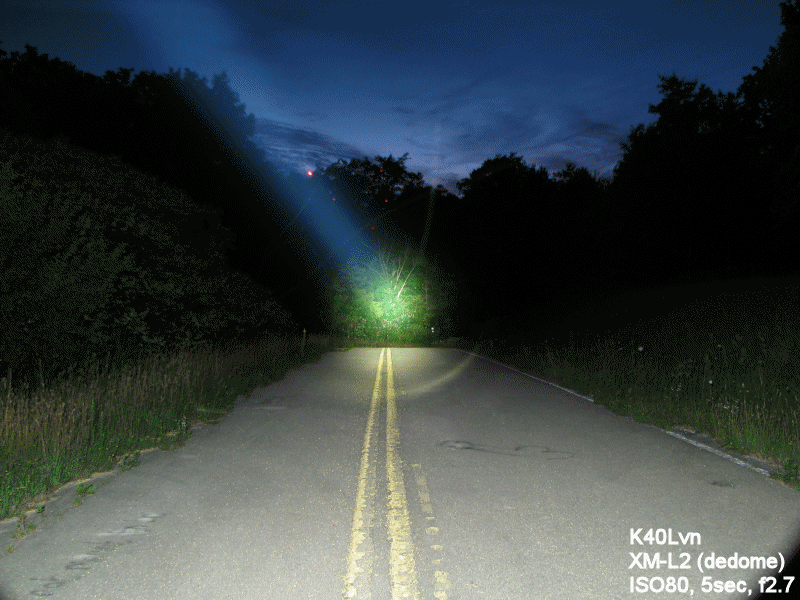
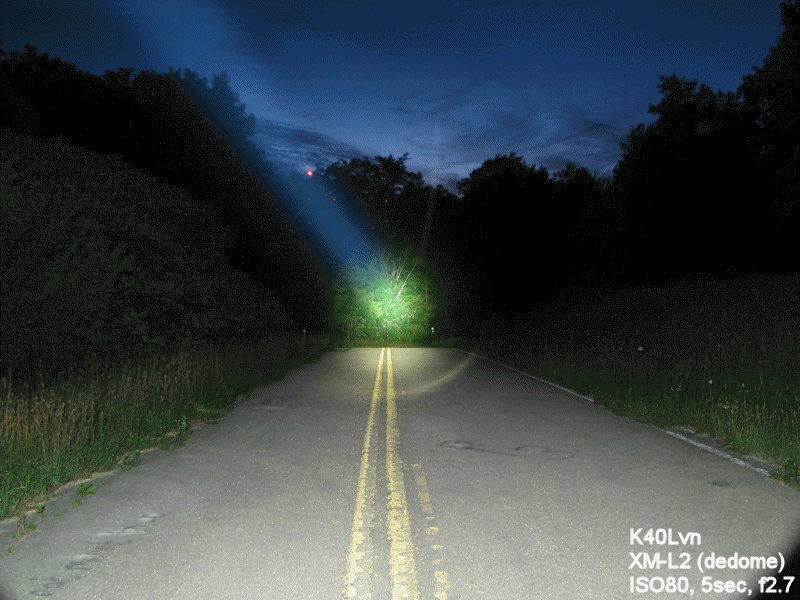
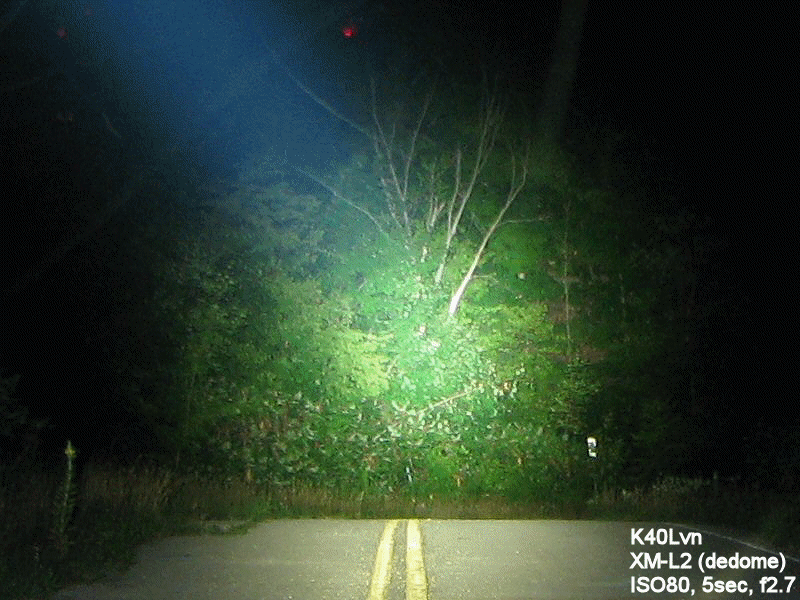
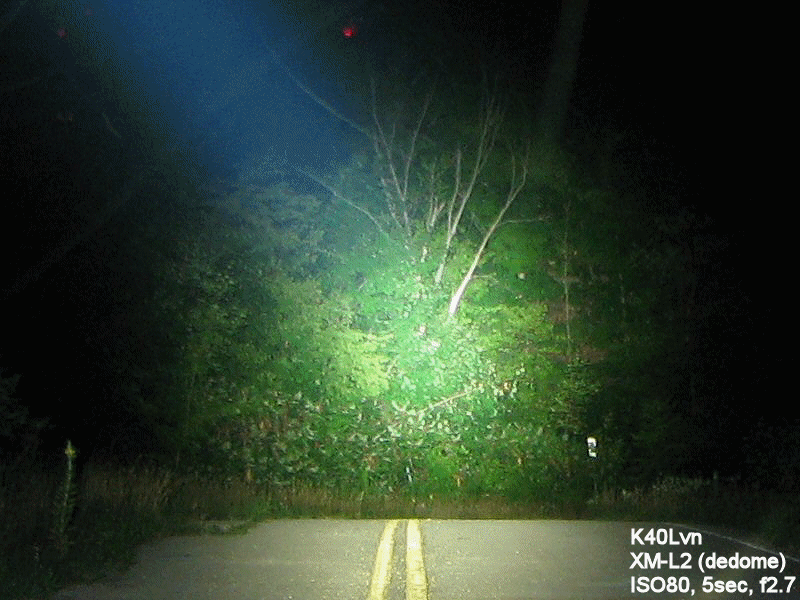
I think this really shows it well. The K40Lvn XP-G2 has a tighter central hotspot than the K40Lvn XP-L - but is not actually any "throwier", due to the lower overall output. The K40Lvn is brighter and throwier than the SR52vn, however.
Scroll down for direct beam measurements.
Testing Method:
All my output numbers are relative for my home-made light box setup, as described on my flashlightreviews.ca website. You can directly compare all my relative output values from different reviews - i.e. an output value of "10" in one graph is the same as "10" in another. All runtimes are done under a cooling fan, except for any extended run Lo/Min modes (i.e. >12 hours) which are done without cooling.
I have devised a method for converting my lightbox relative output values (ROV) to estimated Lumens. See my How to convert Selfbuilt's Lightbox values to Lumens thread for more info.
Throw/Output Summary Chart:
My summary tables are reported in a manner consistent with the ANSI FL-1 standard for flashlight testing. Please see http://www.flashlightreviews.ca/FL1.htm for a discussion, and a description of all the terms used in these tables. Effective July 2012, I have updated all my Peak Intensity/Beam Distance measures with a NIST-certified Extech EA31 lightmeter (orange highlights).
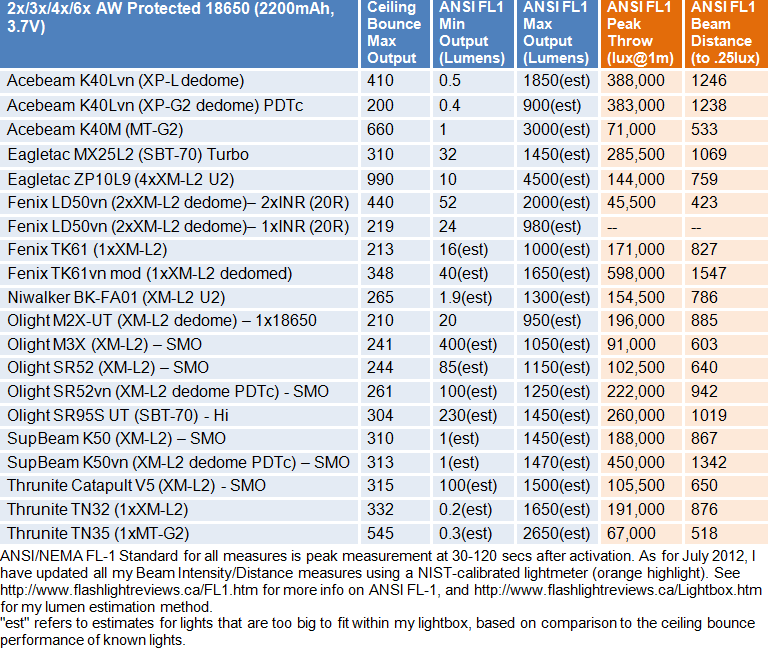
Consistent with the beamshots, the XP-G2 dedome does not actually throw further than the XP-L dedome, due to much lower overall amount of light emitted. There is a very definite bump in output for the K40Lvn XP-L dedome compared to the SR52vn.
The K50vn still has a throw advantage due to the larger head – even though the K40Lvn XP-L dedome is driven harder (i.e., has even greater output).
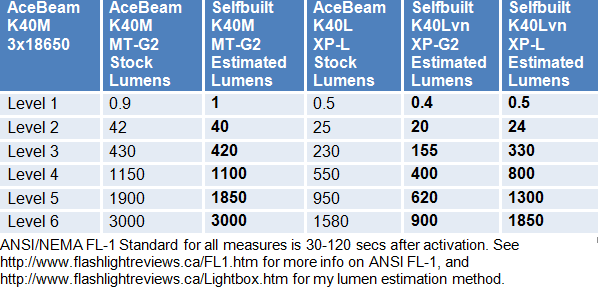
Sorry, I don't have the stock K40L to compare to.
Output/Runtime Comparison:
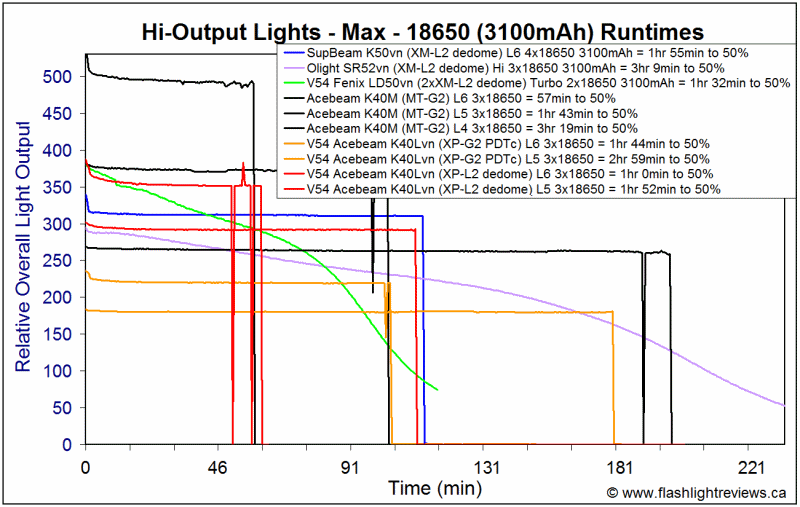
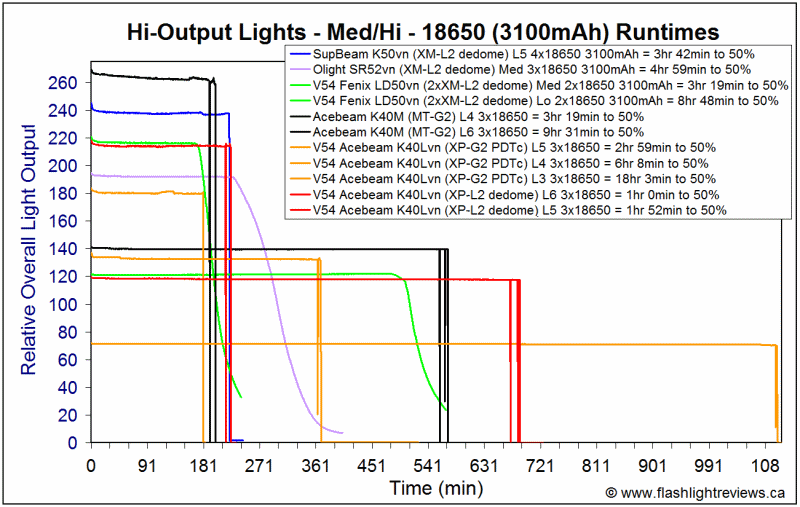
Potential Issues
The XP-G2 dedome doesn't actually throw any further than the XP-L dedome. I suspect the reason for this is because the XP-L dedome can be driven much harder than the XP-G2 dedome (or the typical XM-L2 dedomes that Vinh has done in the past). It may also be that the reflector is optimized for the stock XP-L.
As always, dedoming of the emitter tends to produce a warmer overall beam tint. As expected the "premium dedome tint – cool white (PDTc)" gave a slightly less green-yellow tint than the stock emitter dedome. Long-term reliability of dedomed emitters is unknown.
There are few more artifacts that typical for a Vinh-modded thrower (e.g., rings in the beam). I suspect these are due to the reflector design being optimized for the stock XP-L emitter on the K40L.
As with all lights that share this design, there is a stand-by current when in the "Stand By" mode of the control ring. But this current is very low (60uA), and will not be problem for regular use. And you can easily break this current by clicking the tailswitch off, or loosening the head a quarter turn.
Only 18650 Li-ion cells may be used in the light (i.e., doesn't support multiple CR123A primary cells).
One advantage of the K40Lvn over stock is the updated heatsinking and circuit/carrier tweaks (i.e., improved soldering, thicker gauge wires, etc.) that Vinh performs. Note that unlike the earlier K50vn, there is a definite increase in drive levels on max on the K40Lvn (especially with XP-L). Of course, modding voids all manufacturer warranties, but I know that Vinh stands behind his products.
Preliminary Observations
The stock K50vn has long been a favorite Vinh mod of mine, due to the excellent build quality, interface and throw capabilities of this light. It is however a bit large, so I find I am more likely to grab the more compact SR52vn when I want a high output thrower.
As such, I was curious to see what Vinh could do with the intermediately-sized K40Lvn. I actually have two samples here – one with the smaller XP-G2 emitter (PDTc), and one with the stock XP-L (dedome). The XP-L mod doesn't disappoint – given the much higher boost in maximum output (compared to the K50vn or K40Lvn XP-G2), you get outstanding output and throw for the size. Although hard to generalize from just one sample, the current boost on the XP-L version seems higher than what Vinh normally achieves with the XM-L2 emitter. oo:
oo:
It is interesting to note that the XP-G2 version – which isn't driven as hard as the XP-L (as you might expect) - doesn't actually throw any further than the XP-L dedome. The overall output of the XP-G2 is about half that of the XP-L, limiting the benefit that you get from the smaller emitter. Basically, the XP-G2 would be recommended only if you wanted a "tighter" focused hotspot. Otherwise, most would likely be better off with the XP-L mod.
Like the K50vn, the K40Lvn starts with a great build – with excellent throw, easy lock-out, a physical clicky switch for on/off, and an intuitive control ring with a wide range of output levels. And with the significant current boost on the XP-L mod, you get incredibly high output for the class as well (not to mention outstanding throw). Also as before, the K40L comes with an excellent current-controlled circuit, for great output regulation and overall efficiency.
The only minor drawbacks here are the slightly more "ringy" beam pattern than usual, which may have to do with how the K40L reflector has been optimized for a stock XP-L. However, these were also the first samples Vinh prepared for this mod, so he may have since improved the beam profile adjustment. Keep in mind that all dedome mods are going to have more artifacts – and a significantly green-yellow tint shift – compared to stock dome-on lights.
At the end of the day, I can see the XP-L dedome mod of the K40Lvn becoming a top light for Vinh. Comfortably intermediate in size to the SR52vn and K50vn, the higher output of the XP-L mod gives you one of the best performance/size trade-offs in the modded realm. :wave:
----
K40Lvn XP-G2 and XP-L were provided by Vinh Nguyen (V54) for review.
Also, due to a large backlog of lights that I have to test, I will limit some of the descriptive text in my reviews for the time being. Full commentaries are still provided under the Potential Issues and the Preliminary Discussion sections, but I will let the pictures and graphs speak more themselves in the body of the review.



The stock K40L is a slightly smaller version of the K50 that I reviewed previously (under the SupBeam name). It lacks the in-light charging of the larger K50, and will of course have less throw (but still a lot). It also has an identical build to the K40M (except for the larger MT-G2 emitter in that case).
I have two versions of Vinh's modification on hand for testing – a dedomed stock XP-L, and a dedomed XP-G2 (with Vinh's PDTc - "premium dedome tint – cool white"). Let's see how they perform.
Stock Acebeam K40L Reported Specifications:
- LED: CREE XP-L
- Modes: Level 1 : 0.5lm(2000hrs), Level 2 : 25lm(140hrs), Level 3 : 230lm(20hrs), Level 4 : 550lm(5.5hrs), Level 5 : 950lm(2.8hrs), Level 6 : 1560lm(1.5hrs), Strobe : 560lm (4hrs)
- Battery Configuration: 3 x 18650
- Working Input: 4~13V
- Bean Distance: 760m Max
- Brightness: 1560 Lumens Maximum Brightness
- Intensity: 144300cd
- Runtime: Max 2000hrs
- Material: Aluminum alloy
- Premium Type III hard anodized anti-abrasive finish, black
- Ultra-clear tempered glass lens with anti-reflective coating
- Momentary forward click tactical switch
- Strobe mode for tactical and emergency use
- Smooth reflector for max light output
- Highly focus beam for maximum distance
- Tactical knurling for firm grip
- Streamlined body design
- Mechanical reversed polarity protected design
- Intelligent high efficient circuit for max performance and runtime
- Intelligent temperature controlled light output for safety
- Impact Resistant 1.2m
- Waterproof: IPX8(2m)
- Weight: 453g (without battery)
- Size: 76.2mm(head)X49mm(tube)X186mm(length)
- Package includes: 1XACEBEAM K40L LED Flashlight, 1XRubber button cap, 1XLanyard, 2XO-ring, 1XUser manual, 1XWarranty card, 1XHolster, 1XPacking box
- MSRP: ~$120
- $125 Current boost only
- + $15 XPL HI 6500K or XPG2 PDTc
- + $10 XPL 4000K/5000K or Nichia 219a/b or XPG2 5000K/4000K/2900K
- + $35 Large Copper HS
- + $15 Thermal Pad Cooling for Driver
- + $28 Tailcap with thumb slots
- + $18 international shipping
- + $5 "V54" hand engraved


As per usual for a V54-modded light, packaging of the K40Lvn is the standard stock packaging of the K40L. The K40L comes in a plain cardboard box with packing foam. Along with the light is a holster, extra o-rings, spare boot switch cover, decent quality wrist strap, warranty card, manual, and Vinh's business card.



From left to right: Keeppower protected 18650 3100mAh; Acebeam K40Lvn, K40M; SupBeam K50; Thrunite TN35.
All dimensions are directly measured, and given with no batteries installed:
AceBeam K40Lvn XP-L: Weight: 533.8g, Length: 188mm, Width (bezel): 76.2mm
AceBeam K40Lvn XP-G2: Weight: 539.1g, Length: 188mm, Width (bezel): 76.2mm
AceBeam K40M: Weight: 498.4g, Length: 188mm, Width (bezel): 76.2mm
SupBeam K50vn: Weight: 645.9g, Length: 230mm, Width (bezel): 90.1mm
SupBeam K50: Weight: 645.0g, Length: 230mm, Width (bezel): 90.1mm
Eagletac MX25L3C 3x18650: Weight: 345.9g, 352.0g with kit tailcap (485-491g with 4x18650), Length: 141.9mm, 143.6mm with kit tailcap, Width (bezel): 61.9mm
Fenix TK61: Weight: 605.7g (790g with 4x18650), Length: 218mm, Width (bezel): 96.0mm
Fenix TK61vn: Weight: 608.0g (792g with 4x18650), Length: 218mm, Width (bezel): 96.0mm
Fenix TK75: Weight: 516.0g (700g with 4x18650), Length: 184mm, Width (bezel): 87.5mm
Niwalker BK-FA01 (XM-L2): Weight: 682.3g (864g with 4x18650), Length: 209mm, Width (bezel): 80.0mm, Width (tailcap): 50.3mm
Olight SR52vn: Weight: 401.1g (501g with 6xCR123A), Length: 162mm, Width (bezel): 63.1mm
Olight SR52: Weight: 396.7g (497g with 6xCR123A), Length: 162mm, Width (bezel): 63.1mm
Thrunite TN32 (XM-L2): Weight: 655.9g (808g with 3x18650), Length: 201mm, Width (bezel): 79.0mm
It's interesting to note the higher weight of the K40Lvn mod compared to the K40M (which should be comparable to the stock K40L). That extra 1.2oz (34g) copper heatsink is clearly registering in the weights. :thumbsup:




The only difference to the external styling of the lights is the custom "V54" engraving on the K40Lvn, should you request it.
The K40L build is similar to the K50 reviewed previously, minus the magnetic charging dock and in-light charger. As before, overall build is reminiscent of the Thrunite TN3x-series lights. Anodizing is a flat black, and seems to be in very good shape on my sample. Labels are sharp and clear, and include a serial number.
Rather than traditional knurling, the handle has a checkered pattern. Combined with the ridge detail on the control ring and head, overall grip is pretty good. The light can roll easily however.
The control ring feels and looks like K50. All black, there are slight indents (and raised checkered regions) on the control ring to help with feel. There is a label mark on the control ring that lines up with the labels on the head. The six constant output modes are not individually labeled, but there is a graded output bar pictogram over the first four levels (i.e., shows the direction to turn to raise or lower the output). There are firm detents at each level, with a slight click as you enter into each one.
Screw threads are traditional triangular cut, but seem of good quality. They are anodized, but it is the tension on the spring in the head than determines if you cam lock out the light by a twist. On my sample, a quick turn is enough to lock out the light.
The lights can tailstand. Tailcap has cut-outs to facilitate access to the switch. Switch is a forward clicky switch (i.e., press for momentary, click for locked-on).
Internally, the modded K40Lvn lights received a number of upgrades. Typically, Vinh shores up the internal heatsinking by adding a copper heatsink, and upgraded various components (wires, solder joints, etc.).
Let's take a closer look at the battery carrier:


This is one of the few visible sources of Vinh's mod – you can see the additional wires soldered from the negative terminals to the springs in the carrier. This is to ensure good consistent current flow, through low-resistance wire.
The positive contact points inside the carrier are slightly raised, so all types of 18650 cells should work fine (i.e., true flat-tops, wide and small button-tops). There seems to be plenty of room in the carrier for length, so longer cells should fit fine. All the cells point the same way here (i.e., negative terminals at the base, positive terminals toward the head).
K40Lvn - XP-G2 dedome



K40Lvn - XP-L dedome



The stock K40L head is clearly designed for throw, being relatively smooth and deep (although not as large as 4x18650 K50).
The dedome XP-L and XP-G2 versions were both centered (and well dedomed). The dedoming process greatly improves the focusing of the light. Scroll down for beamshots and direct intensity measures. :wave:
User Interface
The UI is unaffected by the mod. Turn the light off/on by the tailcap clicky – press for momentary, press and release (i.e., click) for constant on.
Change output modes by turning the control ring in the head. Arranged from left-to-right (looking down at the light, held in traditional flashlight carry), the modes are level 1 > level 2 > level 3 > level 4 > level 5 > level 6 (max) > standby > tactical strobe.
No light is produced on standby, but a miniscule current will be drawn to allow the circuit to respond to a ring turn (see below). As always, I recommend you store the light clicked-off at the tailcap, or locked-out by a head twist.
Video:
For more information on the modded K40Lvn, please see my brief overview here:
As with all my videos, I recommend you have annotations turned on. I commonly update the commentary with additional information or clarifications before publicly releasing the video.
Strobe
There is no sign of PWM on any level – the lights are current-controlled. :thumbsup:

The K40L uses an oscillating strobe design, switching between two frequencies every ~0.6secs or so. Here is a blow up of the two frequencies:


As you can see, it rapidly switches between 15.0Hz and 6.4Hz. This is exactly the same as the K50, K50vn and K40M that I previously tested.
Standby Drain
There must be a standby drain when the clicky switch is turned on and the light is in standby position of the control ring. I measured this traditional standby current as 60uA on 3x18650. This is similar to my K50, and not a major concern. Given the in-series arrangement, that would take almost 6 years to fully drain 3100mAh cells.
Note that on other lights that use a similar design (e.g., Thrunite TN3x series), I know there is an additional circuit to assist the switch when high current draw is required. This necessitates a secondary circuit in the tailcap that has its own standby drain when connected to the carrier. Typically, these are in the uA range and not a concern in practice (although it would be additive to the carrier drain below when fully connected).
Beamshots:
And now, what you have all been waiting for.
And sorry in advance – all beamshots should say "XP-L dedome" for the second K40Lvn, not XM-L2.

















It is always, it's hard to tell much about peak intensity throw at such ridiculously close distances.
Interestingly, the K40Lvn XP-L dedome seems to throw equivalently to the XP-G2 dedome - thanks to the much greater output of the XP-L version. The XP-G2 dedome does have a more tightly focused hotspot, as expected.
Note that these were the first samples off Vinh's assembly line, so the focusing may not be as exact as some of the later shipping models. You can definitely see some greater artifacts and "ringiness" in the beams above.
For outdoor shots, these are done in the style of my earlier 100-yard round-up review. Please see that thread for a discussion of the topography (i.e. the road dips in the distance, to better show you the corona in the mid-ground). Note there are a lot of bugs out at this time of year, so expect to see some flight trails.




I think this really shows it well. The K40Lvn XP-G2 has a tighter central hotspot than the K40Lvn XP-L - but is not actually any "throwier", due to the lower overall output. The K40Lvn is brighter and throwier than the SR52vn, however.
Scroll down for direct beam measurements.
Testing Method:
All my output numbers are relative for my home-made light box setup, as described on my flashlightreviews.ca website. You can directly compare all my relative output values from different reviews - i.e. an output value of "10" in one graph is the same as "10" in another. All runtimes are done under a cooling fan, except for any extended run Lo/Min modes (i.e. >12 hours) which are done without cooling.
I have devised a method for converting my lightbox relative output values (ROV) to estimated Lumens. See my How to convert Selfbuilt's Lightbox values to Lumens thread for more info.
Throw/Output Summary Chart:
My summary tables are reported in a manner consistent with the ANSI FL-1 standard for flashlight testing. Please see http://www.flashlightreviews.ca/FL1.htm for a discussion, and a description of all the terms used in these tables. Effective July 2012, I have updated all my Peak Intensity/Beam Distance measures with a NIST-certified Extech EA31 lightmeter (orange highlights).

Consistent with the beamshots, the XP-G2 dedome does not actually throw further than the XP-L dedome, due to much lower overall amount of light emitted. There is a very definite bump in output for the K40Lvn XP-L dedome compared to the SR52vn.
The K50vn still has a throw advantage due to the larger head – even though the K40Lvn XP-L dedome is driven harder (i.e., has even greater output).

Sorry, I don't have the stock K40L to compare to.
Output/Runtime Comparison:


Potential Issues
The XP-G2 dedome doesn't actually throw any further than the XP-L dedome. I suspect the reason for this is because the XP-L dedome can be driven much harder than the XP-G2 dedome (or the typical XM-L2 dedomes that Vinh has done in the past). It may also be that the reflector is optimized for the stock XP-L.
As always, dedoming of the emitter tends to produce a warmer overall beam tint. As expected the "premium dedome tint – cool white (PDTc)" gave a slightly less green-yellow tint than the stock emitter dedome. Long-term reliability of dedomed emitters is unknown.
There are few more artifacts that typical for a Vinh-modded thrower (e.g., rings in the beam). I suspect these are due to the reflector design being optimized for the stock XP-L emitter on the K40L.
As with all lights that share this design, there is a stand-by current when in the "Stand By" mode of the control ring. But this current is very low (60uA), and will not be problem for regular use. And you can easily break this current by clicking the tailswitch off, or loosening the head a quarter turn.
Only 18650 Li-ion cells may be used in the light (i.e., doesn't support multiple CR123A primary cells).
One advantage of the K40Lvn over stock is the updated heatsinking and circuit/carrier tweaks (i.e., improved soldering, thicker gauge wires, etc.) that Vinh performs. Note that unlike the earlier K50vn, there is a definite increase in drive levels on max on the K40Lvn (especially with XP-L). Of course, modding voids all manufacturer warranties, but I know that Vinh stands behind his products.
Preliminary Observations
The stock K50vn has long been a favorite Vinh mod of mine, due to the excellent build quality, interface and throw capabilities of this light. It is however a bit large, so I find I am more likely to grab the more compact SR52vn when I want a high output thrower.
As such, I was curious to see what Vinh could do with the intermediately-sized K40Lvn. I actually have two samples here – one with the smaller XP-G2 emitter (PDTc), and one with the stock XP-L (dedome). The XP-L mod doesn't disappoint – given the much higher boost in maximum output (compared to the K50vn or K40Lvn XP-G2), you get outstanding output and throw for the size. Although hard to generalize from just one sample, the current boost on the XP-L version seems higher than what Vinh normally achieves with the XM-L2 emitter.
It is interesting to note that the XP-G2 version – which isn't driven as hard as the XP-L (as you might expect) - doesn't actually throw any further than the XP-L dedome. The overall output of the XP-G2 is about half that of the XP-L, limiting the benefit that you get from the smaller emitter. Basically, the XP-G2 would be recommended only if you wanted a "tighter" focused hotspot. Otherwise, most would likely be better off with the XP-L mod.
Like the K50vn, the K40Lvn starts with a great build – with excellent throw, easy lock-out, a physical clicky switch for on/off, and an intuitive control ring with a wide range of output levels. And with the significant current boost on the XP-L mod, you get incredibly high output for the class as well (not to mention outstanding throw). Also as before, the K40L comes with an excellent current-controlled circuit, for great output regulation and overall efficiency.
The only minor drawbacks here are the slightly more "ringy" beam pattern than usual, which may have to do with how the K40L reflector has been optimized for a stock XP-L. However, these were also the first samples Vinh prepared for this mod, so he may have since improved the beam profile adjustment. Keep in mind that all dedome mods are going to have more artifacts – and a significantly green-yellow tint shift – compared to stock dome-on lights.
At the end of the day, I can see the XP-L dedome mod of the K40Lvn becoming a top light for Vinh. Comfortably intermediate in size to the SR52vn and K50vn, the higher output of the XP-L mod gives you one of the best performance/size trade-offs in the modded realm. :wave:
----
K40Lvn XP-G2 and XP-L were provided by Vinh Nguyen (V54) for review.

